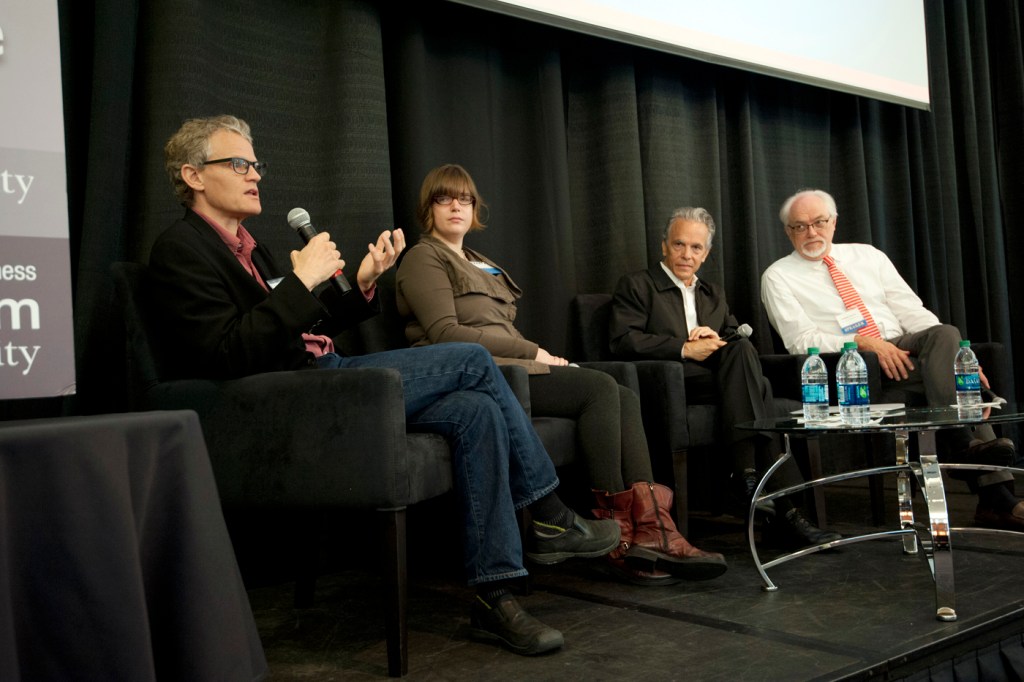How design is driving business and innovation

Northeastern University hosted a conference last month bringing together an interdisciplinary group of academics, entrepreneurs, innovation managers, policy experts, and others to discuss how design is driving new business strategies and practices, re-shaping markets, and redefining demand.
The Institute for Global Innovation Management & IP/Innovation Connection Joint Conference, this year titled “Design: Impact and Challenge,” was sponsored by the D’Amore-McKim School of Business and the School of Law.
Tucker Marion, an associate professor of technological entrepreneurship at Northeastern and co-director of D’Amore-McKim’s Institute for Global Innovation Management, noted in his opening remarks that design is in many ways a buzzword today—and rightfully so. “If you look at Apple’s transformation over the past 15 years, it goes beyond form and function and thinking about the user,” he said. “(Design) goes into business model innovation and services. (It) has a very large impact on what we do, from the smallest startup companies to the largest multinational companies.”
Panel discussions throughout the day focused on emerging design practices; how design is being applied to untraditional industries like biomedical companies and Big Pharma; the emergence of 3-D printing and rapid prototyping; and where intellectual property fits into the conversation.
During the first panel, Tinsley Galyean, founder and principal of Nearlife, noted that his company often interacts with clients at the branding level. “In today’s day and age, for many companies your brand really is the experience that your users and customers are having,” he said. Galyean noted that a prime example of this is Google, which changes its logo everyday with no pushback. “But if they moved the search bar a little bit to one side, we’d all go nuts,” he added. “So the experience of that company and as a brand is really embedded in the user interface.”

Tucker Marion, an associate professor of technological entrepreneurship at Northeastern, delivers opening remarks at the conference. Photo by Matthew Modoono.
During the second panel, the conversation shifted to the pharmaceutical industry. Marco Mancini, AS’98, director for R&D operations transformation and continuous improvement at Bristol-Myers Squibb, noted that while the industry has done a good job designing medicines and medical devices, there is still a big opportunity for innovation when it comes to processes and management.
“Pharma is in desperate need of breakthrough innovation thinking, and I believe that design is a major component of that,” Mancini said. “How do we design the innovation that we’re going to address the challenges that we face? The impact part is (thinking about) how we can really transform our processes and our management to get patients their medicine faster.” He added that Bristol-Myers Squibb is advancing initiatives that enhance innovation and entrepreneurship.
Jeremy Paul, dean of Northeastern’s School of Law, noted that lawyers’ jobs are often viewed as primarily involving litigation and argument. Yet legal professionals throughout history have played an integral role in designing laws and other things for society’s betterment. In fact, he noted that America’s original designers were lawyers, saying that “There’s no more fundamental design document than the Constitution.”
Paul said that one of the law school’s core themes is public interest law. This is true of the recently launched NULawLab, which is exploring new avenues for delivering legal assistance and educating lawyers in order for more people to have access to legal services. The NULawLab is using design thinking as one method to generate new ideas; in one project, the lab is building a hotline to educate domestic workers about their legal rights.
Later in the day, Mark Sivak, who manages Northeastern’s 3-D printing studio in Snell Library’s Digital Media Commons, moderated the panel discussion on what technologies like 3-D printing becoming more ubiquitous means for design. Sivak said there’s been great excitement in recent years regarding the possibilities these technologies offer; he sees it every day when a faculty member prints an educational tool or a physical therapy student prints an anatomy model.
On a global level though, the next big step for 3-D printing is harnessing this “jaw-dropping” technology to maximize its usefulness to individuals and businesses, Sivak said. He expressed concern that the technology could be seen a quick fix to a number of business challenges, including manufacturing.
“The vast majority of 3-D printing still isn’t food safe,” Sivak said, citing coffee mugs as an example. “There’s still a lot to learn about how these will be used as end products.”





